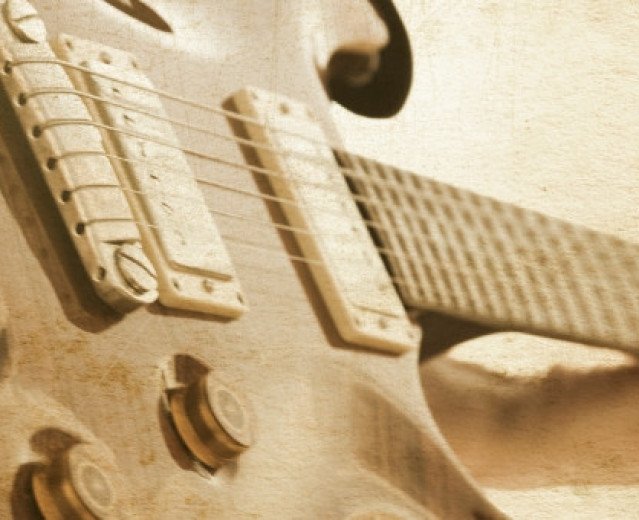This historic and biographic article is preparatory to
the one about the electric guitar vibrato (see an overview on the
Soundsation blog), with special regards to Bigsby and Vibrola
models used on Gretsch and Gibson instruments.
Some articles of the blog are dedicated to more
appreciated and popular vibrato systems as the Fender vintage Stratocaster and the Floyd Rose and Wilkinson floating ones.
Premise
It is well known that people like Les Paul, Paul
Bigsby, Leo Fender and his first associate Doc Kauffman
played a key role in the concept and development of the solid-body electric
guitar and its parts, from pickups to vibrato (or tremolo, under an incorrect though
common name).
Perhaps it is less known these eclectic musicians
and techs were bound by constant hanging out. In fact, in the '40s they
used to meet in Les Paul's garage and laboratory in Hollywood,
California. In the meanwhile, swing, country and Hawaiian music were
raging along with players of folk guitars, lap and pedal steels,
mandolins and ukuleles.
Les Paul
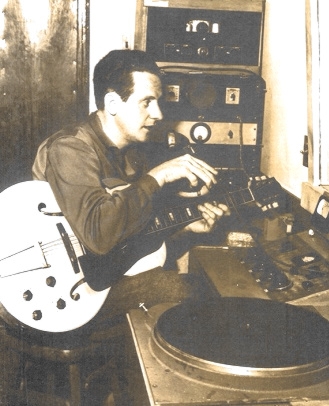
Born in the little town of Waukesha, Wisconsin,
teenager Lester William Polsfuss (1915 – 2009) stood out in the '30s on
the music scene under the pseudonyms of Red Hot Red and Rhubarb Red,
playing a hillbilly and Western swing repertoire. The guitar player
changed his pseudonym in Les Paul as he started devoting himself more
and more to jazz, at first in Chicago and later in New York. He also
continued to play country music regularly, because – by his own admission – it made
more economically. An enthusiast of mechanism comprehension since
he was a child, in Chicago Les collaborated with Swedish brothers Carl and
August Larson, manufacturers of guitars under several brands (Maurer,
Euphonon, Prairie State, Stetson, Stahl), and in New York with Epiphone.
Les used to spend his leisure time in the Epiphone Manhattan factory, working
at a solid body guitar project under the skeptical eyes of owner Epaminondas
“Epi” Stathopoulos. Thus were born, by the end of
the '30s, the basis for the famed demo instruments The Log
(picture below) and The Clunker, built and truly used by Les, but far
from the solid body for which Gibson asked his partnership and endorsement in 1951.
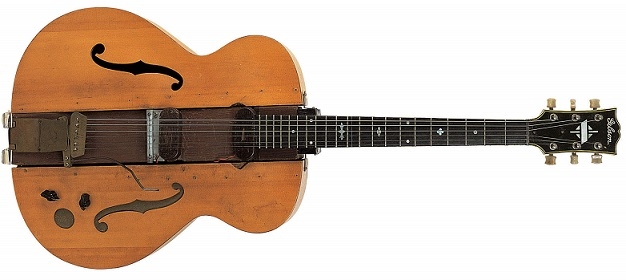
At the beginning of the '40s the guitar player moved
to Los Angeles with his trio and started to accompany the famous singer and
actor Bing Crosby (on the left in the photo).
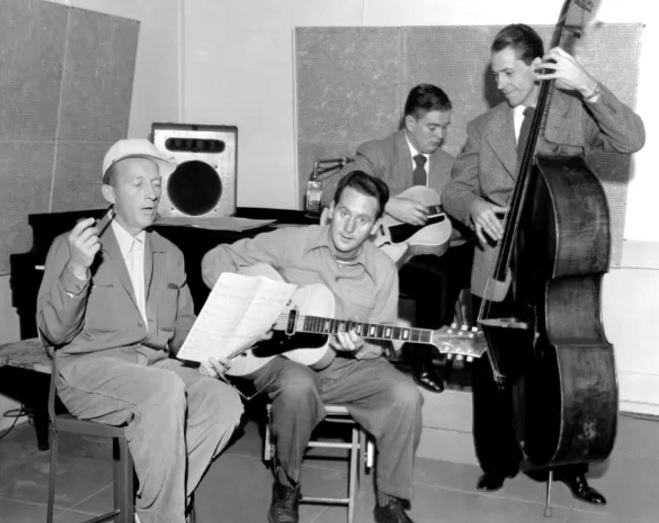
The hiring made Les Paul very popular and appreciated. He began to conduct radio shows and founded a highly successful duo with singer, guitar player and second wife Mary Ford (born Colleen Summers: Les had a head for pseudonyms). In the photo below the guitarist is shown with his wife and... The Clunker.
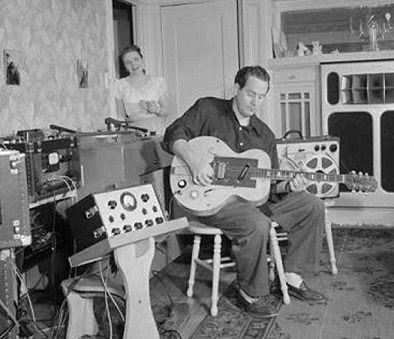
Les Paul was a very active man, aware of the show
biz economical side. Besides his musical projects, he carried on ideas for
guitars, recorders and the delay that today is digitally proposed in modern effects. His house garage in Curson Avenue,
Hollywood, was a laboratory and a recording studio at the same time.
Leo Fender and Doc Kauffman
Clarence Leonidas Fender (1909 –
1991), Leo for all, was born from a wealthy family of orange tree
growers of the Orange County, in Southern California.
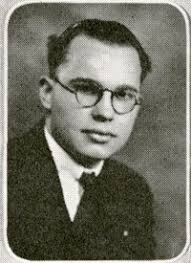
He wasn't a real tech and his proficiency came from a
teenage passion for radio equipment and electronic practice. Leo had played saxophone in the school band and it is said he cannot even tune
a guitar; but he loved Hawaiian, Western swing and country music.
He lost his job as a clerk for California highway
department during the Depression era, and in 1938 he opened the repair lab Fender's Radio Service in Fullerton. We must remember that back then there were tube
radios in every house and they had a great commercial importance.
At the time of his radio laboratory, Leo Fender was
already well known for his audio creations for musicians; but he had to meet
Kansas born guitarist, saxophonist and designer Clayton Orr “Doc” Kauffman
(1901 – 1990) to start an amplifier and lap steel guitar production with
the K&F Manufacturing Company in 1945.
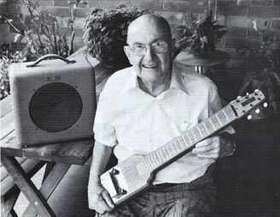
Doc Kauffman was a Rickenbacker's collaborator
and Les Paul's good friend. In 1928 he had applied for a patent for his Apparatus for producing tremolo effects
(perhaps the root of the confusion between tremolo and vibrato).
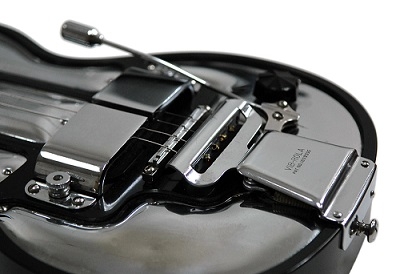
Kauffman's vibrato was called Vib-rola and was
adopted by Les Paul on The Log, by Gibson on some ES-150s and even in a
motorized version by Rickenbacker for 1937 Vibrola Electro Spanish guitars!
Intimidated by Fender's growth aims, Kauffman left the
company in 1946, but the two remained friends. Leo established the Fender
Electric Instrument Company and focused on guitars, hiring George William Fullerton (1923 – 2009), who was a guitar
player, an electronic tech and a mechanical machinist. He designed, by example,
Fender neck shaping machinery.
Fullerton was a fundamental collaborator, he followed Leo Fender at the CLF
Research and was his partner in the G&L Guitars with Dale Hyatt, before he
went to Fender Corporation in 2007.
Well, now let's stop reporting historical
notes about Fender.
Paul Bigsby
Paul Adelburt Bigsby (1899 –
1968), nicknamed P.A., was born in Illinois and then relocated in Los
Angeles, where he worked at the Crocker Motorcycles shop.
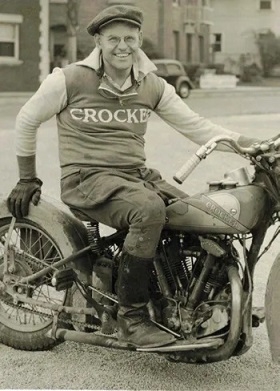
Western swing and country double bass and guitar
player, skilled metallurgist and pro motorcycle racer, Paul was much
better known as an innovative lap and pedal steel guitar builder and
designer (he realized the most popular pedalboard). He had made high level
instruments with his own pickups for renowned musicians as Earl Murphy
and Speedy West. Great country singer, guitarist and composer Merle Travis,
to whom we at least owe the Travis picking technique, asked Paul to fix
his Gibson L-10 Kauffman Vib-rola. This intervention lead Bigsby
to conceive a new and more efficient vibrato, the Bigsby True Vibrato,
released in 1951.
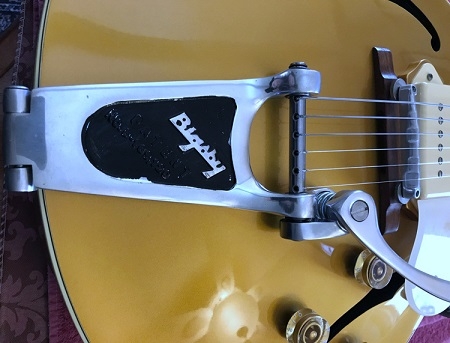
Another Travis' request was the manufacture of a new
guitar featuring the sustain of a lap steel that hollow-body guitars did
not allow. It seems Merle himself drew a sketch of the instrument and suggested
Bigsby to place the tuning machines on the same side. The new guitar was
delivered in 1948. In the picture below, Merle Travis with his Bigsby.
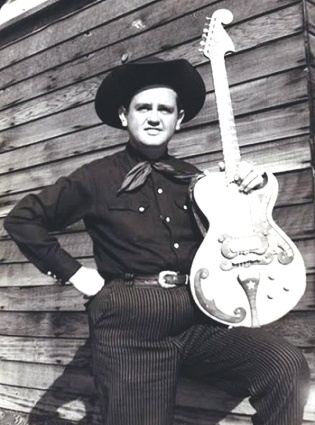
Travis' Bigsby guitar was a 1 1/2” thick maple solid-body with neck-thru-body and string-thru-body construction,
and a single cutaway. The bridge and the nut were made of aluminum, the blade pickup was
built by Bigsby. A three position switch connected different capacitors for
tone variation. The six Kluson tuners on a single row were obtained from two three per side sets.
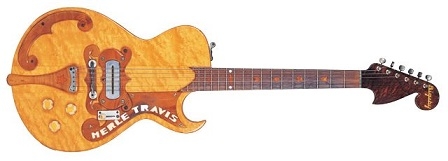
Bigsby Merle Travis guitar was followed by other ones considered among the best of the time and
all made on a custom order basis with long waiting time for famous players as
Hank Garland, Billy
Byrd and Grady Martin (in the picture below).
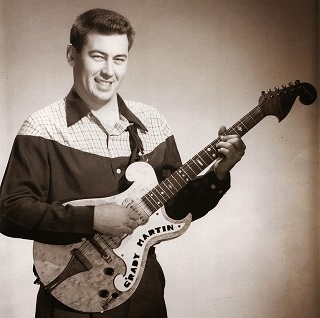
This
instrument surely had a great influence on the solid-body Leo Fender released in 1950, at first as Esquire, then as Broadcaster
and finally as Telecaster since 1951. As shown in the picture, Fender
prototype had three per side tuning machines.
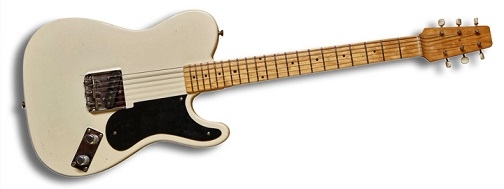
However Paul and Leo remained in good terms, so much
that Bigsby was sending to Fender his own customers asking for solid-bodies.
Moreover, due to his artisan and perfectionist mentality, Bigsby refused
the idea of series production and preferred to focus only on his vibratos.
These were so successful that the former motorcyclist was put to the test by
production and commercial necessities.
In 1965 Paul offered his firm to friend Ted McCarty
(retiring from Gibson), who sold it to Gretsch in 1999. Since 2019 the Bigsby
brand is a property of Fender Musical Instruments Corporation.
Appleton's App guitar
We must remember now the App arched top solid-body
made by Orbra Wallace Appleton (1902 – 1994) in 1941.
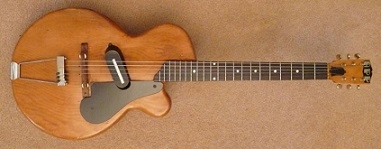
This ukulele and
guitar player worked in a furniture shop and experimented several instrument
amplification solutions. His creation was very similar to the successive Gibson Les Paul guitar, even thicker, but was refused
by Gibson.
Beer and barbecue on the Sunset Strip
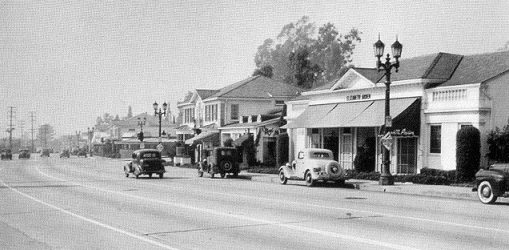
We don't know exactly what topics were the basis of
the evenings of Leo Fender and Paul Bigsby at Les Paul's, near the so-called Sunset
Strip area of clubs and bars. As for all enthusiasts, there is no doubt
that music and guitar were at the center of their talks. Bigsby and
Fender were curious to listen to guitarist's studio recordings and to know
which techniques and instruments he had used. Between a beer and another, among
the possible topics they couldn't miss Les Paul's experiments to build a new
kind of electric guitar, those of Fender and Bigsby about the lap steels
and the pickups they both made, and Bigsby's solid-body for Merle
Travis. Among these matters they surely couldn't miss new ideas for vibrato systems
too.
It is known that Bigsby provided to Fender his
vibratos for some specially modified Telecasters. It is likely that Leo Fender
desired to surpass Kauffman's and Bigsby's designs and decided to stay out of
the challenge until 1954, when his fabulous Stratocaster debuted with
the newly designed and well working Synchronized
Tremolo. This system and its
setup are described in depth in a specific blog article.
Doc Kauffman's Vib-rola was to inspire a quite
unsuccessful Gibson model, the so-called Sideways Vibrola, later
replaced by the Maestro Vibrola. Instead, the Bigsby True Vibrato is
still appreciated and largely used today on hollow and solid-body guitars made
all over the world.
This matter is dealt with in the Soundsation blog article
“Bigsby, Gibson and other vibratos”!
Fabrizio Dadò
References
B.Tolinski, A.Di Perna, Play It Loud: An Epic History of the Style, Sound, and
Revolution of the Electric Guitar – Doubleday, 2016.
G.Gruhn, W.Carter, Electric Guitars & Basses - A photographic history – Miller Freeman Books, 1994.
